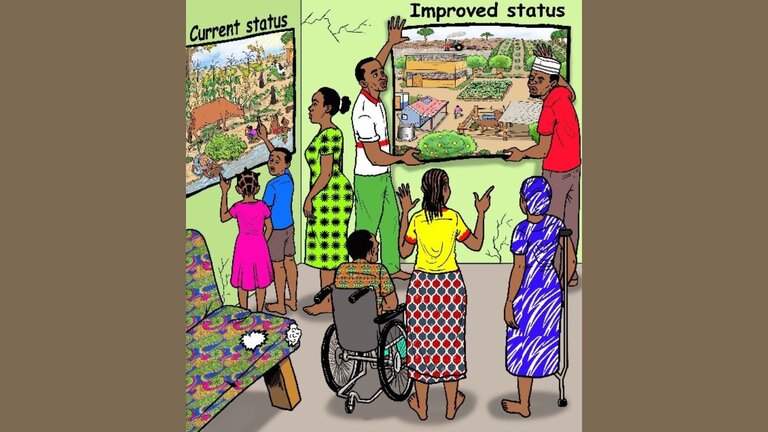Introduction to the PIP Approach
To enhance food security for Persons with Disabilities in the West Nile and Acholi sub regions, ZOA employs a participatory farming model called Integrated Farm Plan (PIP) approach developed by Wageningen University. This Approach has been priorly used in countries Burundi.

Integrated Farm Plan (PIP) is a participatory farming approach used in empowering smallholder farmers to be Stewards of land which enables having optimal conditions of soils for sustainable agricultural production.
PIP is an innovative way of transforming small scale subsistence farmer households into a more productive and sustainable farms through household plans drawn that visualizes the current situation of the farm and the desired future situation and is accompanied by an action plan made by the family (entire Household). This should be an inclusive plan by all household members .
PIP Foundation Principles
The principle operates on the three key aspects of motivation, stewardship and resilience;
- Motivation; Is an intrinsic inspiration to act and triggers an action to be undertaken. Here members don’t attach material gains like cash, food, inputs etc. to undertake an activity they have planned. It is the most crucial principle for sustainable change because it leads to ownership, genuine engagement in more stewardship.
- Stewardship; refers to responsibility to manage and protect land and its natural heritage. In PIP, it is stimulated by creating awareness about changes in natural resources and our own role, inducing responsibility in stakeholders to protect and observe land, water & vegetation. This can only be achieved through awareness about environmental values such as prevention of pollution, protection of environment & respect for the earth.
- Resilience; Is ability of a system to return to its initial state after a shock or perturbation. In PIP, it implies focusing on both physical aspects of farming, as well as coping capacities of the households and villages; Strategies to achieve resilience; On farm resilience practices include diversification of crops, income sources and practices to address challenges of land scarcity for agriculture and vulnerability to climatic risks, non-farm income sources, high quality cash crops and livestock. Social resilience include education, skills, knowledge, health & organization.
PIP Guiding Principles
The above foundation principles are guided by three principles that support sustainability;
- Empowerment; concerns a process in which people gain control over their lives, develop a sense of self determination and eventually believe in their capability to change their own realities. Actors (farmers) make their own decisions_ bottom-up approach. In PIP approach, farmers become aware of the ability to transform reality through conscious collective (household) action_ learn how to solve their own problems.
- Integration; In PIP, different farmers come up with different ideas to solve their problems and social challenges like soil erosion etc. Different enterprises like crop production, animal production and business enterprises that diversify their food and income security options. It stimulates social cohesion as members become eager to learn from others, It is a guiding principle for stakeholders to see a farm or village as a system where everything is connected where farmers during their work are stimulated to learn more and experiment with new activities and practices.
- Collaboration; Is the basic tool in achieving a sustainable change, when people carry out actions together e.g. at slope level, working together to implement soil and water conservation practices, at community level, building a village knowledge center or storage facility, Collaboration enhances trust and social relations among people.
Phases of PIP creation
PIP creation goes through 4 major phases;
- Phase 1: Awareness raising at community level; (e.g Stakeholder, Community Awareness creation Meetings
- Phase 2: PIP creation with the Model Farmers(PIs);
(Has structured stages to involve farmer households i.e. Explaining the purpose and background of PIP, Drawing the actual situation of the farm; Drawing the “family tree”; Making an inventory of skills, assets and aspirations of all family members;
Drawing the desired future situation of the farm (the “dream PIP”) and Making the action plan)
- Phase 3: PIP scaling-up in each community;
It starts by training the PIs to become Farmer Trainers, and then focuses on scaling-up towards community level by means of the PIP competitions; hence, spreading the PIP approach from the PIs to groups of farmers, and then to community level. After the PIP competition, Model Farmers (PIs) embrace farmer to farmer training approach so that household members are fully involved in the processes of PIP creation and implementation.
Village vision development
The vision transferred from the PIs to the 2nd generation PIP farmers (during the first PIP competition) triggers intrinsic motivation and an increased awareness, especially on integrated farm management and sustainable land management. This stimulates the need for collaboration, as a foundation for scaling-up from the individual visions to collective and community/village visions.
- Phase 4: PIP scaling-up to adjacent communities;
This phase describes how to continue working with these PIP farmers in the new communities, and how to ignite also the PIP Concept to cover the majority of farmer families in these communities. At this stage, the role of the extension service is a key factor: The Sub County Extension Officers’ active participation in this scaling-up phase is essential to embed the PIP approach within the extension service and spread the PIP fever even further towards more communities.
